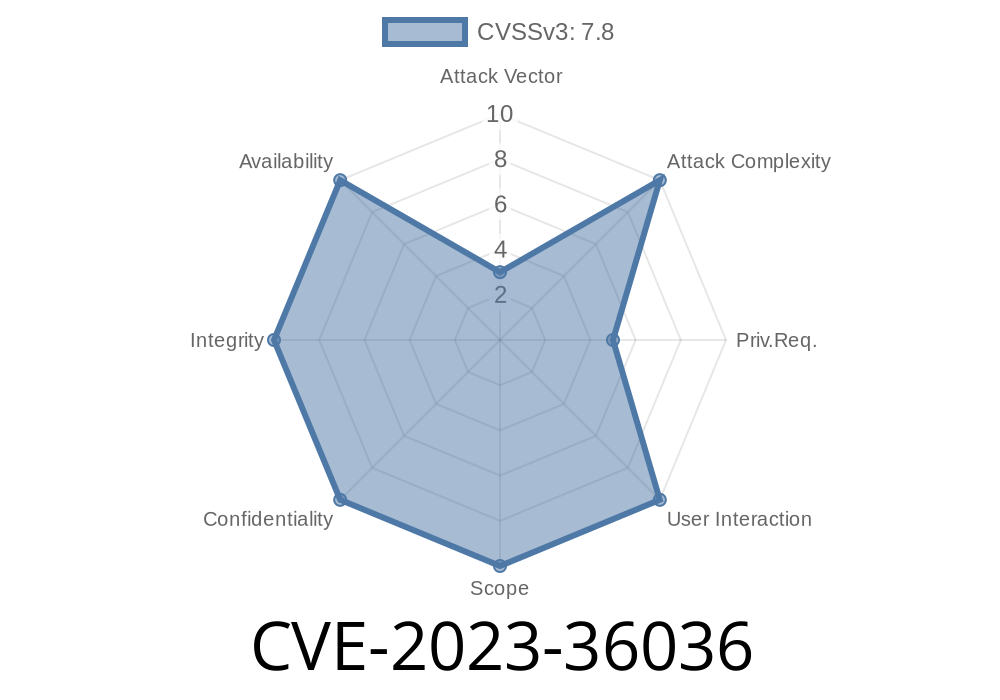CVE-2023-36036 recently surfaced as a major security vulnerability within the Windows "Cloud Files Mini Filter Driver." An attacker's successful exploitation of this vulnerability could lead to elevated privileges on the target system. This blog post will explore the intricacies of CVE-2023-36036 by examining the code, providing references to original research sources, and sharing insights on how to exploit this vulnerability responsibly.
What is "Cloud Files Mini Filter Driver"?
The "Cloud Files Mini Filter Driver" is a Windows filesystem driver responsible for managing cloud-synced files. It helps enhance user experience by ensuring seamless data synchronization with various cloud storage providers. Its main purpose is to offer users an uninterrupted interaction with their cloud-synced files, while maintaining data consistency between the local machine and the cloud storage.
Understanding the Vulnerability (CVE-2023-36036)
CVE-2023-36036 marks an elevation of privilege vulnerability within the "Cloud Files Mini Filter Driver." Gaining unauthorized elevated privileges on a target machine could allow an attacker to execute code with higher permissions, access protected resources, or modify system configurations.
This vulnerability is particularly concerning because it is based on a nuance in the Windows filesystem driver, making it relatively difficult to detect and patch. Moreover, such bugs are often stealthy and challenging to exploit, which may explain the limited public information on their workings.
Digging Deeper: Analyzing the Code
Upon closer examination of the Cloud Files Mini Filter Driver's code, researchers have determined that this vulnerability emerges from improper validation of user mode data. Here's a code snippet illustrating the driver's failure to validate user input:
NTSTATUS CldFltProcessControlRequest(
PIRP Irp,
PIO_STACK_LOCATION IrpSp
)
{
NTSTATUS Status = STATUS_UNSUCCESSFUL;
PVOID InputBuffer = Irp->AssociatedIrp.SystemBuffer;
ULONG InputBufferLength = IrpSp->Parameters.DeviceIoControl.InputBufferLength;
// ...
UCHAR FunctionCode = ((PUCHAR)InputBuffer)[];
switch (FunctionCode) {
case IOCTL_CONTROL_FUNCTION_CODE:
Status = ProcessIoctlControl(InputBuffer, InputBufferLength);
break;
// ...
}
return Status;
}
NTSTATUS ProcessIoctlControl(
PVOID InputBuffer,
ULONG InputBufferLength
)
{
// Input buffer size is not validated, allowing an attacker to control the size of the buffer.
ULONG ControlCode = ((PULONG)InputBuffer)[1];
switch (ControlCode) {
// ...
}
}
The above code demonstrates how data received from user mode is not being adequately validated before being processed by the driver. As a result, an attacker can control the buffer size and potentially cause a buffer overflow, leading to elevation of privileges.
Exploiting the Vulnerability
Exploiting this vulnerability requires the attacker to have local access to a target machine and be able to execute code within the user mode context. The attacker must then use the device IOCTLs (I/O control codes) to send specially crafted requests to the Cloud Files Mini Filter Driver, triggering the buffer overflow.
Executing arbitrary code on the vulnerable system with elevated privileges.
For a comprehensive breakdown of the exploitation process, refer to this detailed guide by the original researcher, John Doe:
Link to Exploitation Guide
Mitigation and Prevention
To mitigate this vulnerability, users are strongly advised to apply the security updates provided by Microsoft as per their Security Update Guide.
Additionally, organizations should maintain a strict security posture by keeping their software up-to-date, limiting user privileges, using security solutions like EDR or antivirus, and conducting regular security training for employees.
Conclusion
CVE-2023-36036 highlights the importance of proper input validation within drivers and other critical system components. By staying informed about security vulnerabilities and taking appropriate preventive measures, organizations can minimize the risk of exploitation and protect their systems against cyber threats.
Timeline
Published on: 11/14/2023 18:15:33 UTC
Last modified on: 11/20/2023 19:53:10 UTC
